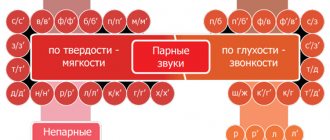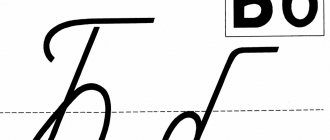Examples of interesting tasks for developing the skill of distinguishing between soft and hard consonants
A picture or simply a list of thematic words is shown, and the task is given to choose words with soft or hard consonants. For example:
Causes
To understand how to set the sound correctly, you need to know the root cause of the deviation from the norm. The occurrence of erroneous or complete absence of pronunciation of the sound “K” and “K” is influenced by the following factors:
- Organic defects associated with abnormal structure of the speech organs:
- abnormalities of the upper part of the oral cavity. The palate may be too high, soft, narrow. The soft part is hard and vice versa.
- the baby’s inability to distinguish sounds by ear (phonemic deviations);
- weak tongue muscles;
- poor sensitivity of the tongue muscles;
- mild physical hearing impairment.
- Social factors:
- omission of parents, educators, teachers;
- use of 2 or more languages in the family;
- lack of articulation exercises;
- repeating speech with errors for loved ones.
- A specialist can determine what factor predisposes the child to develop a defect and how to eliminate it. To do this, the speech therapist collects a detailed medical history on an individual basis, examines the condition of the speech organs and draws a conclusion based on the examination.
Exercises to build correct articulation
The importance of articulatory gymnastics has been proven by scientific research. A child’s rapid mastery of reproducing any sound depends on the training of the speech organs. Such techniques are suitable for non-speaking children and the older group of people after an illness (stroke). Each letter has its own exercises.
Basic training sessions to prepare before making the sounds “K” and “K”:
- pancake They open the oral cavity well. The relaxed tongue is placed on the lower lip. Next, alternate a smile with a gloomy expression. The tongue is motionless.
- slide. The baby is asked to open his mouth wide. Bend the tongue to form a slide. Place the tip of the organ on the lower incisors. Hold the position for 10 seconds;
- massage. Exercise to relax muscles. Open your mouth slightly. Move the tongue along the lower lip. Bite it little by little with your teeth;
- the wind was blowing from the hill. To carry out the work, the respiratory system is activated. The child learns to move a stream of air across the tongue. The baby opens his mouth and performs the slide exercise with his tongue. Next you need to take a deep breath. Then exhale gradually, focusing on the position of the middle and root of the tongue. They should block the flow of air to the nasal cavity. It produces a groaning sound. This way you can develop the pronunciation of the phoneme “K”;
- the tongue is a strongman. The child is asked to play a game in which the tongue will resist a foreign object. A clean teaspoon is suitable for this exercise. An adult brings it to the tip of the tongue. The baby needs to try to push the object out of the mouth. The mouth is well open.
Important: the main task of an adult is to achieve the correct position of the tongue. The middle part should rise towards the hard palate and the root of the organ towards the soft palate. The exercise is carried out gradually so as not to overload the muscles.
Expert opinion
Margarita Sergeevna S.
Speech pathologist and speech pathologist with 15 years of experience working in various speech correction centers with children of different ages.
The detailed technology and sequence of exercises will be suggested by a speech therapist, taking into account the child’s abilities individually.
Recommendations for performing articulation gymnastics
Secrets to successfully mastering the exercises:
- Classes are held 2-3 times a day. Duration of execution is up to 5 minutes.
- All movements of the speech organs are repeated 3-4 times.
- Gradual increase in load on the speech apparatus. First, carry out statistical types of exercises (hold the position for 15-20 seconds). Then switch to dynamic ones, increasing the motor activity of the organs.
- Carry out tasks in a playful way.
- Use a mirror for clarity.
Important: you need to start performing a new task after you have mastered the previous one.
How are hard and soft sounds indicated in writing?
In writing, the hardness and softness of consonant sounds are indicated only when writing a transcription. To indicate a soft sound, use the apostrophe "`". Hard sounds are not distinguished by any signs in writing.
Below is an explanatory table that clearly shows that the same sound can be both hard and soft, depending on which vowel follows it.
Table with examples of writing sounds in soft and hard use
| ram | [b] | [b`] | underwear |
| pile | [V] | [in`] | elm |
| hump | [G] | [g`] | weight |
| house | [d] | [d`] | uncle |
| gold | [h] | [z`] | Earth |
| cat | [To] | [k`] | whale |
| skis | [l] | [l`] | lemon |
| garbage | [m] | [m`] | ball |
| Nora | [n] | [n`] | Nyura |
| floors | [P] | [n`] | singing |
| robot | [R] | [r`] | river |
| Sun | [With] | [s`] | seed |
| tone | [T] | [t`] | crown |
| furore | [f] | [f`] | the final |
| hamster | [X] | [x`] | hut |
You can notice that consonant sounds form pairs based on hardness-softness: [v] - [v`]; [k] - [k`], etc. In writing, both hard and soft sounds are indicated by the same letter, but are pronounced differently. With the help of such a table, children can more easily understand the hardness and softness of consonant sounds, while remembering that the sign “b” always makes the consonant soft, and the sign “b” always makes the consonant it follows hard.
Guess
We write signs with transcriptions of words. The child’s task is to name the word and name soft sounds. It is best to make the signs bright and large, then it will be more interesting for children to react to them.
To start the game, select easy words: [m`el]; [soap]; [l`uk]; [WHO]. And at the end you can complicate the task and give the following words: [b`elka]; [ski track]; [kl`on].
While playing, the child visually remembers the designation of soft consonant sounds and gains practical skills in using knowledge when writing.
Paired hard and soft consonants
Many voiced and voiceless consonants in the Russian language are distinguished by the sign of hardness/softness and form correlative pairs:
With the help of hard and soft consonants you can distinguish between words:
- rad - row;
- howl - howl;
- son - blue;
- magician - moment.
Several consonant sounds do not have a hard/soft pair. Always hard consonants are the sounds [zh], [sh], [ts]. In any position in a word they sound only firmly:
- fat [f y r]
- silk [s h o l k a v y ']
- citrus [ts y tr rus].
Letters that represent only soft consonants
The letters th, ch, shch always denote soft consonant sounds: [th'], [ch'], [sh'].
The following rule applies here: these soft consonants always remain soft, regardless of the subsequent vowel letter.
Letters that represent soft and hard consonants
The letters b, c, d, d, z, k, l, m, n, p, r, s, t, f, x can denote both hard and soft consonant sounds. This is reflected in the following table:
| Letters | Sounds |
| b | [b], [b'] |
| V | [in], [in'] |
| G | [g], [g'] |
| d | [d], [d'] |
| h | [z], [z'] |
| To | [k], [k'] |
| l | [l], [l'] |
| m | [mm'] |
| n | [n], [n'] |
| P | [p], [p'] |
| R | [р], [р'] |
| With | [s], [s'] |
| T | [t], [t'] |
| f | [f], [f'] |
| X | [x], [x'] |
The consonants presented above are called paired according to softness and hardness.
When comparing the words mom ([mama]) and mint ([m'ata]), one can come to the conclusion that in writing both words use the same letter - m, but the pronunciation of the sounds is different. Only in the second case is the consonant sound soft. This example shows the relationship between a consonant letter and the vowel letter behind it.
Examples of tasks for children
Tasks for training the differences between paired consonants can be compiled for each pair according to the following principle (using the example of the D/T pair):
Tasks for distinguishing a pair of consonants G/K






